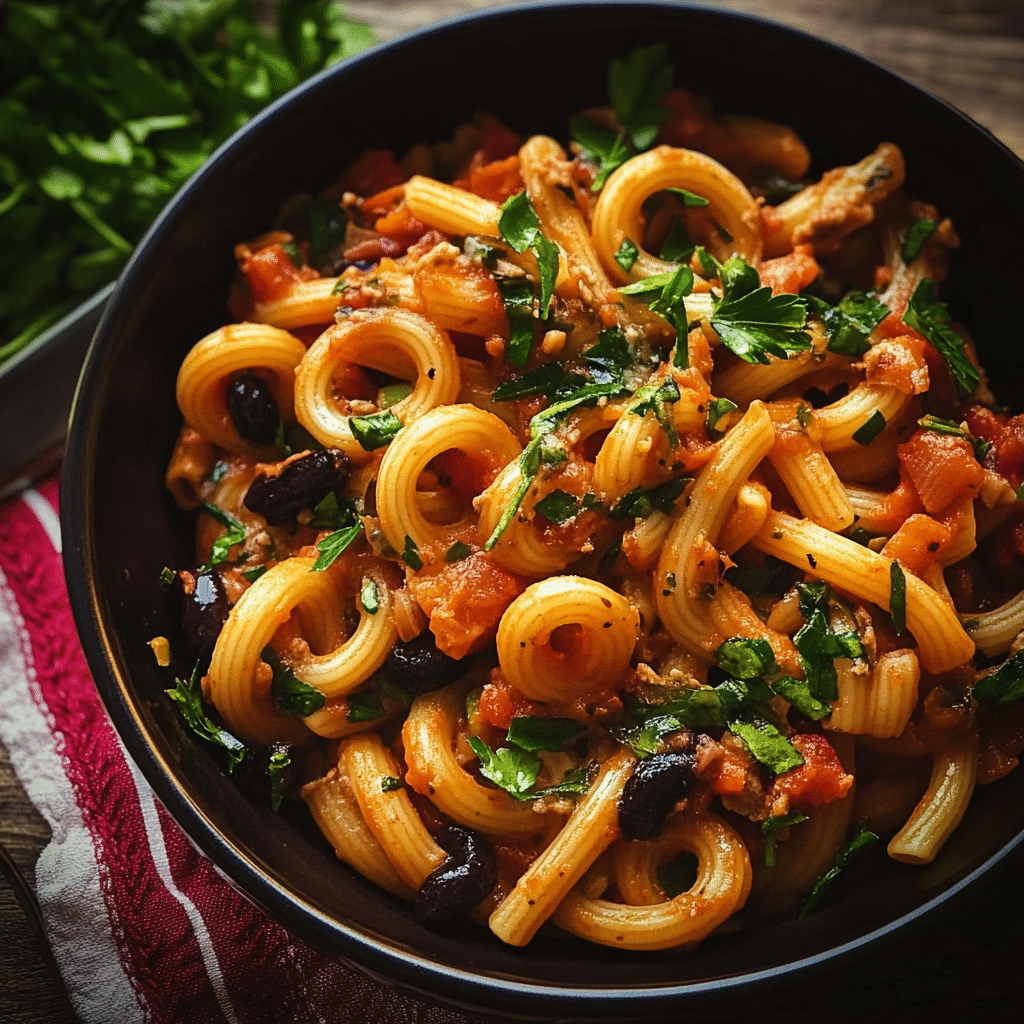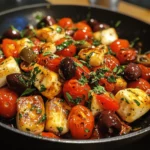This Pasta Puttanesca, sans anchovies, has become an absolute revelation in my kitchen, a dish that proves you don’t always need every traditional ingredient to capture the soul of a classic. The first time I made this version, I was a little hesitant, wondering if it could truly deliver that iconic, punchy Puttanesca flavor my family adores without the umami depth of anchovies. To my utter delight, and theirs, it was a resounding success! The combination of briny olives, tangy capers, rich tomatoes, and a feisty kick of chili, all simmered together, created a sauce so robust and satisfying that no one even missed the fish. It’s now our go-to for a quick, incredibly flavorful weeknight meal that feels both rustic and sophisticated, and I’m so excited to share this surprisingly complete version with you.
Why This Pasta Puttanesca (Without Anchovies!) Will Captivate Your Taste Buds
Pasta alla Puttanesca, traditionally known for its bold, assertive flavors, often includes anchovies for a deep umami kick. However, this version proves that you can achieve a remarkably similar and equally delicious experience without them, making it a fantastic option for vegetarians, those with fish allergies, or simply anyone who prefers to skip the anchovies.
- Intensely Flavorful & Robust: Even without anchovies, this sauce packs a serious flavor punch. The magic lies in the synergistic combination of salty Kalamata olives, briny capers, pungent garlic, sweet and acidic tomatoes, and a lively spark from red pepper flakes.
- Pantry Staple Superstar: One of the best things about Puttanesca is that it primarily relies on pantry staples. Canned tomatoes, olives, capers, pasta, garlic, and olive oil are items many of us have on hand, making it an ideal “what’s-for-dinner?” solution.
- Quick and Easy to Prepare: From start to finish, you can have this vibrant pasta dish on the table in about 30 minutes. It’s perfect for busy weeknights when you crave something satisfying without spending hours in the kitchen.
- Vegetarian & Easily Vegan: This recipe is naturally vegetarian. To make it vegan, simply ensure your pasta is egg-free and omit or use a vegan alternative for any Parmesan cheese garnish.
- Surprisingly Complex for Simple Ingredients: The way the individual flavors meld and deepen during a short simmer creates a sauce that tastes like it’s been lovingly tended to for much longer.
- Customizable Heat: You control the spice level. Love it fiery? Add more red pepper flakes. Prefer a milder warmth? Use just a pinch.
This isn’t just a “Puttanesca alternative”; it’s a standout dish in its own right, proving that thoughtful ingredient combinations can create culinary magic.
Ingredients for Authentic Flavor (Minus the Fish)
To create this vibrant and satisfying Pasta Puttanesca without anchovies, you’ll need the following high-quality ingredients:
- Pasta: 1 pound (450g) linguine, spaghetti, bucatini, or penne (use your favorite long or short cut)
- Extra Virgin Olive Oil: ¼ cup (60ml), plus more for drizzling
- Garlic: 4-6 cloves, thinly sliced or minced (depending on your preference for garlic intensity)
- Red Pepper Flakes (Chili Flakes): ½ – 1 teaspoon, or to taste (adjust based on your spice preference)
- Kalamata Olives: ¾ cup, pitted and roughly chopped or halved (use good quality, oil-cured if possible)
- Capers: ¼ cup, drained (if salt-packed, rinse them well)
- Canned Whole Peeled Tomatoes: 1 large can (28 ounces / 794g), preferably San Marzano, crushed by hand or with a spoon
- (Alternatively, you can use diced tomatoes, but whole peeled tomatoes often have a better flavor and texture when crushed)
- Tomato Paste: 1 tablespoon (optional, but adds depth and umami)
- Dried Oregano: 1 teaspoon (or 1 tablespoon fresh, chopped)
- Fresh Parsley: ½ cup, freshly chopped, plus more for garnish
- Salt: To taste (be mindful as olives and capers are salty)
- Freshly Ground Black Pepper: To taste
- Reserved Pasta Water: About 1 cup (you may not use it all)
Optional Umami Boosters (to compensate for no anchovies):
- Mushroom Powder: 1 teaspoon of dried porcini mushroom powder (adds earthy depth)
- Miso Paste: 1 teaspoon white or yellow miso paste (stir into a little warm water before adding to the sauce – adds savory complexity) – use sparingly as it’s salty
Step-by-Step Instructions to a Perfect Puttanesca
Follow these simple steps to create a restaurant-quality Pasta Puttanesca in your own kitchen. The key is to build layers of flavor.
1. Prepare the Ingredients (Mise en Place):
- Bring a large pot of salted water to a rolling boil for the pasta.
- Pit and roughly chop the Kalamata olives.
- Drain the capers (and rinse if salt-packed).
- Thinly slice or mince the garlic.
- Chop the fresh parsley.
- Have your canned tomatoes ready to be crushed, or open the can of diced tomatoes.
- Measure out red pepper flakes, oregano, and tomato paste (if using).
2. Cook the Pasta:
- Once the water is boiling vigorously, add the pasta and a generous pinch of salt.
- Cook according to package directions until al dente (tender but still firm to the bite).
- Crucially: Before draining the pasta, reserve about 1 to 1.5 cups of the starchy pasta water. This water is liquid gold for helping the sauce emulsify and cling to the pasta.
- Drain the pasta but do not rinse it.
3. Start the Sauce Base:
- While the pasta is cooking, heat the ¼ cup of extra virgin olive oil in a large, heavy-bottomed skillet or Dutch oven over medium heat.
- Add the sliced or minced garlic and the red pepper flakes. Cook for 1-2 minutes, stirring frequently, until the garlic is fragrant and lightly golden. Be very careful not to burn the garlic, as it will become bitter. The red pepper flakes will bloom in the oil, releasing their flavor and heat.
4. Build the Flavor Layers:
- Add the chopped Kalamata olives and drained capers to the skillet. Stir and cook for 2-3 minutes, allowing them to release their briny flavors into the oil.
- If using tomato paste, add it now. Cook for 1-2 minutes, stirring constantly, until it darkens slightly. This step caramelizes the tomato paste, deepening its flavor.
- If using mushroom powder or miso paste (dissolved in a little water), add them now and stir to incorporate.
5. Add Tomatoes and Simmer:
- Pour in the hand-crushed whole peeled tomatoes (and their juices) or the diced tomatoes. Add the dried oregano.
- Stir everything together well. Bring the sauce to a gentle simmer.
- Reduce the heat to low, cover partially (to prevent splattering but allow steam to escape), and let the sauce simmer for at least 10-15 minutes, or while your pasta finishes cooking. This simmering time allows the flavors to meld and deepen. Stir occasionally.
- If the sauce becomes too thick during simmering, you can add a splash of the reserved pasta water.
6. Finish the Sauce and Combine with Pasta:
- Once the sauce has simmered and the pasta is cooked and drained (with pasta water reserved!), stir most of the chopped fresh parsley into the sauce, reserving some for garnish.
- Taste the sauce and adjust seasoning with salt (be cautious, as olives and capers are already salty) and freshly ground black pepper as needed.
- Add the drained pasta directly to the skillet with the Puttanesca sauce.
- Add about ½ cup of the reserved starchy pasta water to the skillet. Toss everything together vigorously over medium heat for 1-2 minutes. The pasta water will help the sauce emulsify, thicken slightly, and coat every strand of pasta beautifully. If the sauce seems too dry, add a little more pasta water until it reaches your desired consistency – it should be glossy and cling to the pasta, not watery.
7. Serve:
- Divide the Pasta Puttanesca among warmed serving bowls or plates.
- Garnish with the remaining fresh parsley.
- A drizzle of good quality extra virgin olive oil over each serving adds a lovely finishing touch.
- If desired, offer freshly grated Parmesan cheese (or a vegan Parmesan alternative) on the side, though traditional Puttanesca is often served without cheese.
Nutrition Facts (Approximate)
Please note that these nutritional values are estimates and can vary based on specific ingredient brands, exact portion sizes, and any optional additions. This estimate is for the pasta and sauce, excluding optional cheese.
- Servings: This recipe typically yields 4-6 servings.
- Calories per serving (assuming 4 large servings): Approximately 550-650 calories.
This dish, especially when made with whole wheat pasta, can be a good source of fiber from the tomatoes and pasta. Olives provide healthy monounsaturated fats. It’s naturally cholesterol-free (if no animal products are added).
Preparation and Cook Time
Understanding the time commitment can help you plan your meal efficiently:
- Preparation Time: 10-15 minutes (This includes boiling water for pasta, chopping olives, garlic, parsley, and opening cans. “Mise en place” is quick for this dish.)
- Cook Time: 20-25 minutes (Cooking pasta and simmering the sauce simultaneously.)
- Total Time: Approximately 30-40 minutes
This makes Pasta Puttanesca without anchovies an excellent choice for a quick, flavorful, and satisfying meal any night of the week.
How to Serve Your Vibrant Puttanesca
This bold and zesty pasta dish is fantastic on its own but can be beautifully complemented by a few simple additions:
- Garnishes:
- A generous sprinkle of freshly chopped flat-leaf parsley is essential for freshness and color.
- A final drizzle of high-quality extra virgin olive oil over each serving enhances the richness.
- A few extra Kalamata olives or capers for visual appeal and an extra briny pop.
- More red pepper flakes on the side for those who love an extra fiery kick.
- Traditionally, cheese isn’t a dominant feature in Puttanesca, but a light grating of Pecorino Romano or Parmesan cheese (or a vegan alternative like nutritional yeast mixed with ground cashews) can be offered if desired.
- Bread:
- Serve with slices of crusty Italian bread or focaccia for mopping up every last bit of the delicious sauce. Garlic bread would also be a delightful accompaniment.
- Salad:
- A simple green salad with a light vinaigrette (lemon and olive oil) can provide a refreshing contrast to the richness of the pasta.
- An Arugula salad with shaved Parmesan and a lemon dressing also pairs beautifully.
- Wine Pairing:
- Red Wine: A medium-bodied Italian red like Chianti, Sangiovese, or Nero d’Avola complements the robust tomato and olive flavors.
- White Wine: A crisp, dry Italian white such as Pinot Grigio, Vermentino, or Verdicchio can cut through the richness and highlight the briny notes.
- Serving Setting:
- Serve in wide, shallow pasta bowls to best showcase the dish.
- Warm the bowls before serving to keep the pasta hot longer.
This dish is inherently rustic and comforting, so simple, heartfelt presentation is all it needs.
Additional Tips for a Sensational Sauce (Even Without Anchovies!)
To truly make your anchovy-free Pasta Puttanesca sing, consider these essential tips:
- Boost Umami Creatively: Since anchovies are the traditional umami powerhouse in Puttanesca, you can compensate by:
- Caramelizing Tomato Paste: Don’t just stir it in; cook the tomato paste for a minute or two until it darkens slightly. This intensifies its flavor and adds depth.
- Mushroom Power: A teaspoon of dried porcini mushroom powder mixed into the sauce adds an incredible earthy, savory note that mimics some of the complexity anchovies provide.
- A Touch of Miso: A small amount of white or yellow miso paste (dissolved in a little warm water before adding) can introduce a subtle, fermented savoriness. Use sparingly, as it’s also salty.
- Quality Ingredients are Key: With a simple sauce like Puttanesca, the quality of each component shines through.
- Tomatoes: Use good quality canned San Marzano tomatoes if possible. Their sweetness and lower acidity make a noticeable difference. Crushing whole peeled tomatoes by hand often yields a better texture than pre-diced.
- Olives: Opt for flavorful Kalamata olives, preferably oil-cured or those packed in brine, not bland canned black olives.
- Olive Oil: A good quality extra virgin olive oil forms the flavor base of your sauce and adds richness.
- Don’t Skimp on Olives and Capers: These are your primary salt and brine contributors in an anchovy-free version. Ensure you use the full amounts called for, or even a little more if you love their assertive flavor. Remember to rinse salt-packed capers well, or your dish could become overly salty.
- The Magic of Starchy Pasta Water: Never underestimate the power of that cloudy pasta cooking water! It’s rich in starch, which helps to emulsify the olive oil and tomato sauce, creating a smoother, more cohesive sauce that clings beautifully to the pasta. Always reserve at least a cup before draining your pasta.
- Simmer for Flavor Development: While Puttanesca is a quick sauce, allowing it to simmer for at least 10-15 minutes (while the pasta cooks) is crucial. This gives the garlic, olives, capers, and tomatoes time to meld and deepen into a harmonious, robust flavor profile. A longer, gentle simmer (up to 30 minutes if you have time) will only make it better.
Frequently Asked Questions (FAQ)
Here are answers to some common questions about making Pasta Puttanesca without anchovies:
- Q: Will the Puttanesca taste significantly different without anchovies?
A: While anchovies do contribute a specific type of salty, umami depth, this version is designed to build a similar complexity using other ingredients. The combination of intensely flavored olives, capers, garlic, chili, and potentially umami-boosters like tomato paste caramelization or mushroom powder creates a sauce that is still very much “Puttanesca” in spirit – bold, briny, and incredibly satisfying. Many people find they don’t miss the anchovies at all. - Q: Can I make this dish spicier or milder?
A: Absolutely! The level of heat is entirely up to you.- For spicier: Increase the amount of red pepper flakes. You could also add a pinch of cayenne pepper or a finely minced fresh chili (like a bird’s eye or serrano) along with the garlic.
- For milder: Reduce the red pepper flakes to ¼ teaspoon or even just a tiny pinch, or omit them entirely if you are very sensitive to heat.
- Q: What kind of olives are best for Puttanesca?
A: Kalamata olives are the classic choice and highly recommended for their rich, fruity, and slightly smoky flavor. Other good options include oil-cured black olives (like Gaeta or Niçoise, though the latter are smaller and milder). Avoid using standard canned black olives (like Mission olives), as they lack the intense flavor needed for this dish. - Q: Can I add other vegetables or proteins to this Puttanesca?
A: While classic Puttanesca is quite specific, you can certainly adapt it.- Vegetables: Some people like to add finely diced bell peppers or zucchini, sautéed with the garlic. However, this will make it deviate from the traditional profile.
- Protein: For a non-vegetarian version (that’s still anchovy-free), you could add cooked shredded chicken or pan-seared shrimp towards the end. For a heartier vegetarian/vegan meal, consider adding cannellini beans or chickpeas.
- Q: How should I store and reheat leftover Pasta Puttanesca?
A: Store leftovers in an airtight container in the refrigerator for up to 3-4 days. To reheat, gently warm the pasta and sauce in a skillet over medium-low heat. Add a splash of water or vegetable broth if the sauce has thickened too much upon refrigeration. You can also microwave leftovers, but skillet reheating tends to yield better results for pasta texture. The flavors often meld and can be even better the next day!
This Pasta Puttanesca without anchovies is a testament to the power of simple, high-quality ingredients working in harmony. It’s a dish that’s both unapologetically bold and wonderfully comforting, ready to bring a taste of rustic Italy to your table in no time. Enjoy the process and the delicious results!
Print
Pasta Puttanesca Without Anchovies recipe
Ingredients
-
- Pasta: 1 pound (450g) linguine, spaghetti, bucatini, or penne (use your favorite long or short cut)
-
- Extra Virgin Olive Oil: ¼ cup (60ml), plus more for drizzling
-
- Garlic: 4-6 cloves, thinly sliced or minced (depending on your preference for garlic intensity)
-
- Red Pepper Flakes (Chili Flakes): ½ – 1 teaspoon, or to taste (adjust based on your spice preference)
-
- Kalamata Olives: ¾ cup, pitted and roughly chopped or halved (use good quality, oil-cured if possible)
-
- Capers: ¼ cup, drained (if salt-packed, rinse them well)
-
- Canned Whole Peeled Tomatoes: 1 large can (28 ounces / 794g), preferably San Marzano, crushed by hand or with a spoon
-
- (Alternatively, you can use diced tomatoes, but whole peeled tomatoes often have a better flavor and texture when crushed)
-
- Canned Whole Peeled Tomatoes: 1 large can (28 ounces / 794g), preferably San Marzano, crushed by hand or with a spoon
-
- Tomato Paste: 1 tablespoon (optional, but adds depth and umami)
-
- Dried Oregano: 1 teaspoon (or 1 tablespoon fresh, chopped)
-
- Fresh Parsley: ½ cup, freshly chopped, plus more for garnish
-
- Salt: To taste (be mindful as olives and capers are salty)
-
- Freshly Ground Black Pepper: To taste
-
- Reserved Pasta Water: About 1 cup (you may not use it all)
Optional Umami Boosters (to compensate for no anchovies):
-
- Mushroom Powder: 1 teaspoon of dried porcini mushroom powder (adds earthy depth)
-
- Miso Paste: 1 teaspoon white or yellow miso paste (stir into a little warm water before adding to the sauce – adds savory complexity) – use sparingly as it’s salty
Instructions
1. Prepare the Ingredients (Mise en Place):
-
- Bring a large pot of salted water to a rolling boil for the pasta.
-
- Pit and roughly chop the Kalamata olives.
-
- Drain the capers (and rinse if salt-packed).
-
- Thinly slice or mince the garlic.
-
- Chop the fresh parsley.
-
- Have your canned tomatoes ready to be crushed, or open the can of diced tomatoes.
-
- Measure out red pepper flakes, oregano, and tomato paste (if using).
2. Cook the Pasta:
-
- Once the water is boiling vigorously, add the pasta and a generous pinch of salt.
-
- Cook according to package directions until al dente (tender but still firm to the bite).
-
- Crucially: Before draining the pasta, reserve about 1 to 1.5 cups of the starchy pasta water. This water is liquid gold for helping the sauce emulsify and cling to the pasta.
-
- Drain the pasta but do not rinse it.
3. Start the Sauce Base:
-
- While the pasta is cooking, heat the ¼ cup of extra virgin olive oil in a large, heavy-bottomed skillet or Dutch oven over medium heat.
-
- Add the sliced or minced garlic and the red pepper flakes. Cook for 1-2 minutes, stirring frequently, until the garlic is fragrant and lightly golden. Be very careful not to burn the garlic, as it will become bitter. The red pepper flakes will bloom in the oil, releasing their flavor and heat.
4. Build the Flavor Layers:
-
- Add the chopped Kalamata olives and drained capers to the skillet. Stir and cook for 2-3 minutes, allowing them to release their briny flavors into the oil.
-
- If using tomato paste, add it now. Cook for 1-2 minutes, stirring constantly, until it darkens slightly. This step caramelizes the tomato paste, deepening its flavor.
-
- If using mushroom powder or miso paste (dissolved in a little water), add them now and stir to incorporate.
5. Add Tomatoes and Simmer:
-
- Pour in the hand-crushed whole peeled tomatoes (and their juices) or the diced tomatoes. Add the dried oregano.
-
- Stir everything together well. Bring the sauce to a gentle simmer.
-
- Reduce the heat to low, cover partially (to prevent splattering but allow steam to escape), and let the sauce simmer for at least 10-15 minutes, or while your pasta finishes cooking. This simmering time allows the flavors to meld and deepen. Stir occasionally.
-
- If the sauce becomes too thick during simmering, you can add a splash of the reserved pasta water.
6. Finish the Sauce and Combine with Pasta:
-
- Once the sauce has simmered and the pasta is cooked and drained (with pasta water reserved!), stir most of the chopped fresh parsley into the sauce, reserving some for garnish.
-
- Taste the sauce and adjust seasoning with salt (be cautious, as olives and capers are already salty) and freshly ground black pepper as needed.
-
- Add the drained pasta directly to the skillet with the Puttanesca sauce.
-
- Add about ½ cup of the reserved starchy pasta water to the skillet. Toss everything together vigorously over medium heat for 1-2 minutes. The pasta water will help the sauce emulsify, thicken slightly, and coat every strand of pasta beautifully. If the sauce seems too dry, add a little more pasta water until it reaches your desired consistency – it should be glossy and cling to the pasta, not watery.
7. Serve:
-
- Divide the Pasta Puttanesca among warmed serving bowls or plates.
-
- Garnish with the remaining fresh parsley.
-
- A drizzle of good quality extra virgin olive oil over each serving adds a lovely finishing touch.
-
- If desired, offer freshly grated Parmesan cheese (or a vegan Parmesan alternative) on the side, though traditional Puttanesca is often served without cheese.
Nutrition
- Serving Size: one normal portion
- Calories: 550-650






